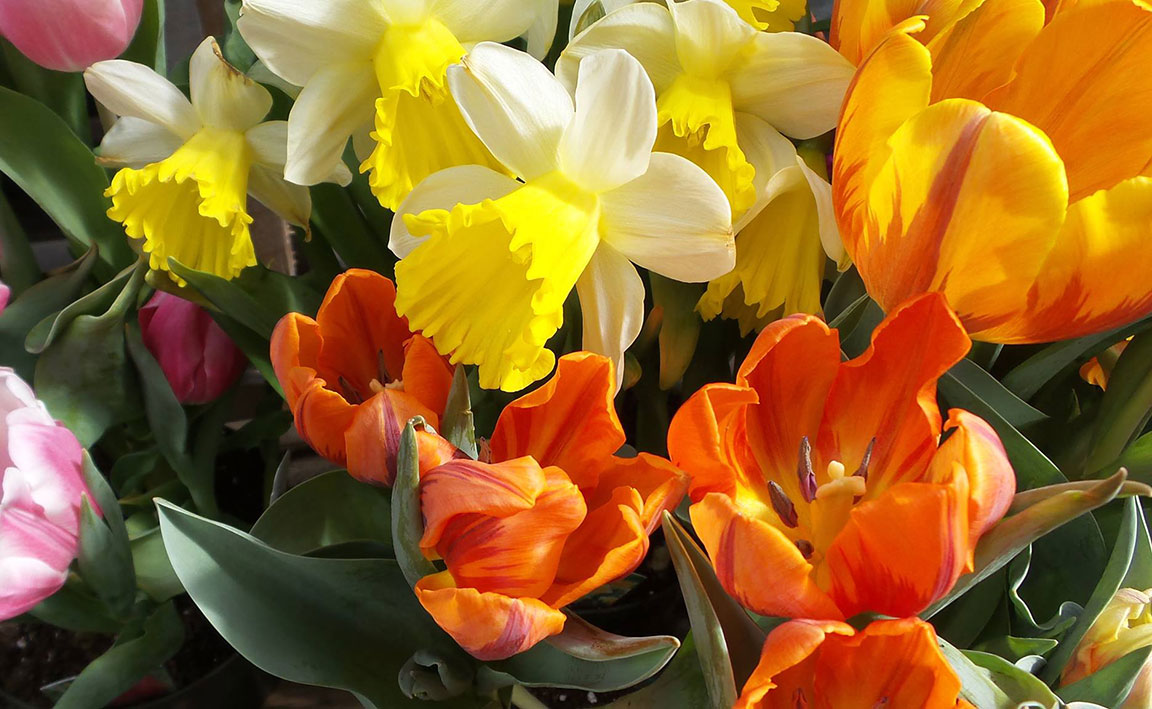
Maine Home Garden News — April 2019
- April Is the Month to . . .
- Home Grafting Techniques
- Crazy Worms in Maine
- Blue Cohosh (Caulophyllum thalictroides)
- Adopt a Family: A Unique Approach to Matching Small-scale Growers with Young Maine Families
- Food & Nutrition: Food Safety and Backyard Flock
April Is the Month to . . .
By Rebecca Long, Agriculture and Food Systems Professional, UMaine Extension Oxford County
- Take advantage of your last chance to remove browntail moth webs! The caterpillars will begin to emerge in mid-April. With 25 – 400+ per colony, every web removed can make a big impact. Webs are found most often on red oak and apple trees. The invasive browntail moths not only defoliate hardwood trees and shrubs, but also pose a health risk to humans. Contact with poisonous hairs from the caterpillar can cause a poison ivy like rash and trouble breathing. This Browntail Moth Exposure Risk 2019 Map (PDF) shows the current distribution of browntail moths in Maine. To find out how to identify webs and distinguish them from old fall webworm webs, read Browntail Moth (PDF). A video from the Maine Forest Service on Browntail Moth demonstrates how to remove the webs. Make sure to dispose of them properly by burning nests or putting them in soapy water. Wear gloves and rinse or shower after handling webs. The Bowdoinham library has purchased a pole pruner to borrow for folks in that region. For professional help, these lists include licensed arborists willing to prune (PDF) and licensed pesticide applicators willing to spray (PDF) nests.
- Purchase and begin setting up your irrigation system. With the increasing frequency of summer droughts, having a way to irrigate your garden is becoming more important. Although startup costs add to your gardening expenses, this publication from Vermont Extension explains that drip irrigation (PDF) is an excellent way to efficiently deliver water to your plants, saving time, increasing yields, and reducing overall water use. Sprinklers offer a more affordable way to deliver water, but make sure to run them early in the day. Running sprinklers midday can result in excessive evaporation loss and running them in the evening risks leaving leaves wet overnight, which can promote disease. Lastly, set up a rain gauge to keep track of precipitation so you know when to water. On average, plants need approximately 1” to 1 ¼” of rain per week.
-

Coltsfoot (Tussilago farfara); photo by C. Eves-Thomas. Look around your landscape for early pollinator resources. Early in spring, pollinators rely heavily on flowering shrubs and trees like willows (Salix species) and serviceberry (Amelanchier species). Even plants considered to be weeds, like dandelions (Taraxacum spp.) and coltsfoot (Tussilago farfara), can be important sources of early season forage for pollinators. For bees that produce multiple generations per year, early forage sources can encourage more nests nearby and increase the success rate of those nests.
- Start seeds! Beets, peas, radish, and spinach can be direct-seeded outside in mid- to late April; for lots of other crops see Planting Chart for the Home Garden Vegetable Garden and Startintg Seeds at Home indoors! Make sure plants started indoors are in big enough containers to avoid becoming pot-bound and ensure plants are hardened off before transplanting outdoors.
- Sanitize pots, hand tools, equipment, trellises, and supports from previous years. Start the year off on the right foot by making sure you’re not introducing pathogens from the previous year! If you haven’t cleaned your tools before you put them away in the fall (the ideal approach), there’s still time to do it now: Cleaning Gardening Tools. First, determine if sanitizing is even necessary; this fact sheet from WSU on Sterilized Pruning Tools (PDF) explains that disinfection is important if you are dealing with diseases of the vascular system or those that form oozing cankers. As for determining how to disinfect, this article, The Myth of Cloroxed Clippers (PDF), questions the traditional wisdom of using bleach and instead advocates for Lysol-like products as an option that is safer for both you and your tools.
- When designing your ornamental beds, consider the trend of including edible plants in decorative plantings. Rainbow Swiss chard or okra look equally at home in a flower bed or a vegetable garden!
Home Grafting Techniques
By Thomas Hoerth, Southern Maine Community College Instructor, Retired Bath City Arborist, Middle Hoerth Winter Gardens
Do you have a cider blend that you’d like to grow on just one tree? Have you eaten an apple that you’d like to add to your orchard? Is there an old, abandoned apple tree on the edge of your woods you’d like to bring back into production? Have borers and voles girdled a prized fruit tree? Has a tree been damaged by excessive string trimming or plow damage?
Many homeowners experience these kinds of situations and are unaware that they can utilize techniques that were known to the Chinese, as far back as 1560 B.C., themselves. The art and practice of connecting two pieces of living plant tissue together in such a manner that they will unite and subsequently grow and develop as one composite plant is what is referred to as grafting. There are innumerable procedures that have been developed, and through the years several distinct methods have become established for practitioners and the nursery industry to deal with almost any grafting problems or to expedite propagation of specific plant varieties. For the homeowner, who is comfortable using a sharp knife, several techniques, described here, can be used to accomplish the goals identified in the above questions. Success is achieved in using the correct technique, preparing the plants for joining, and the timing of the grafting.

Let’s start with some definitions used in grafting. The rootstock is the lower portion of the composite plant, which develops into the root system. It may be a rooted cutting or clonal rootstock, used in bench grafting or whip grafting, or an established tree onto which you wish to graft an additional variety, as is done in top-working. The choice of rootstock determines the mature height of the resulting tree, as well as provides resistance or tolerance of soil-borne diseases and pests. The scion is a short piece of shoot tissue containing several dormant buds, ideally taken from the middle third of a 1-year-old shoot. This shoot will grow and develop into the upper portion of the resulting composite tree, and has been chosen for desired fruit, flower, and capacity to provide reliable pollen, among other reasons. The vascular cambium is the layer of tissue where the cells are capable of dividing and differentiating into new xylem and phloem (the plants “plumbing system”). These layers are found in both the rootstock and scion wood, and should be lined up in order for the cells to successfully bridge and unite the two together. The term bench-graft refers to working with rootstock and scion wood out of the ground (ex: potted plants). Top-working refers to working with these materials in the field, on an existing tree. Repair grafts are also done with these materials in the field, on an existing tree.

Three techniques will be discussed to address the goals above. The first technique is the whip-and-tongue graft. Used in making a new tree using a chosen rootstock and scion wood of a desired apple variety, both pieces of tissue are cut with a sloping angled slice, with a reverse cut near the center, to create the “tongue.” Both pieces are fitted together and sealed with grafting tape or surveyors tape with the named fruit variety written on the tape.
The second technique is the bark graft (rind graft). This is used when looking to restore an abandoned fruit tree or to re-work the top of a producing tree with a new variety. The root stock or tree is sliced when the bark is “slippery,” in the early spring with a 1-2” cut through the bark.
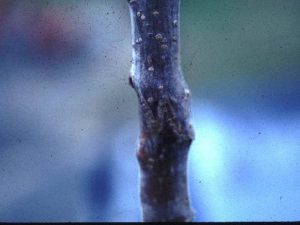
The scion wood is prepared by making a 1- to 2-inch-long cut on one side, and a shorter cut on the opposite side. The bark on the root stock is separated from the wood and the scion wood is inserted between the bark and the wood on the root stock with the long cut next to the wood, leaving no exposed cut tissue. Two to three scion wood pieces are installed this way, and the stem is wrapped with grafting tape or surveyors tape with the variety name written on it. The cut end of the root stock is sealed with grafting wax or roofing tar.
The third techniques are inarching and bridge grafting. Both are used to repair trees that have had significant damage to or removal of the trunk’s bark. In the use of inarching, both the rootstock and scion plants are on their own root systems at the time of the grafting. The root stocks are planted beside the damaged tree and grafted onto the trunk above the area damaged. In bridge grafting, the tree has been injured with a loss of bark tissue. Scion wood is cut long enough to “bridge” the span of missing bark, inserted under healthy bark tissue and then sealed. Scions should be inserted every 2 inches around the trunk area damaged. Assure that the scion wood is right side up.
In all of these techniques, the time of year to conduct them is in the early spring (March-April), or when the buds are dormant. Immediately after grafting, the union should be sealed or wrapped to protect from desiccation. The new composite plants can be planted as soon as you can work the ground. Keep the roots on the bench grafted trees moist until you can plant them. Ensure that the graft union is above the ground level when planting.
You’ll know the graft has been successful or “taken” when you observe the buds on the scion wood break and begin to grow. Leave the wrapping on for the first growing season. After several growing seasons you’ll be able to enjoy your new fruit and know you can add other varieties as you discover them!
Crazy Worms in Maine
By Gary Fish, State Horticulturist Maine Department of Agriculture, Conservation and Forestry
Due to our history of glaciation, there are no native earthworms in Maine. Non-native earthworms from Europe, such as night crawlers, became well established in Maine through early colonial trading with Europe. While beneficial to gardens, earthworms are known to have destructive effects on our forests.
Crazy worms, (Amynthas agrestis), are invasive earthworms native to East Asia. Originating in Korea and Japan, the crazy worm is now found from Maine to South Carolina. Although first collected from a Maine greenhouse in 1899, an established population of this active and damaging pest was not discovered until 2014 when populations were discovered at the Viles Arboretum in Augusta, one other Augusta location, and two Portland sites. We believe crazy worms are not yet wide-spread here, but they have been discovered in many new locations since 2014, including nursery settings. If allowed to spread, crazy worms could cause serious damage to horticultural crops and forest ecosystems in Maine. It is illegal to import them into Maine (or to propagate or possess them) without a wildlife importation permit from the Maine Department of Inland Fisheries and Wildlife (MDIFW). For more information, visit the MDIFW’s Fish & Wildlife in Captivity webpage.
Crazy worm basics
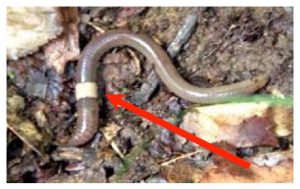
The name speaks for itself! When handled, they act crazy, jump and thrash and behave more like a threatened snake than a worm. Further, they may shed their tails when caught. Crazy worms can be 1.5 to 8 inches long. They also move rapidly on top of the soil.
The narrow band around their body (clitellum) is milky white and smooth, unlike other species which have a raised clitellum (see photo). Crazy worms reproduce easily. They are asexual (parthenogenetic) and mature in just 60 days, so each year they can have two hatches. The best time to find them is late June to mid-October. From September until the first hard frost their population will double and may reach damaging levels. In the nursery setting they can often be found underneath pots that are sitting on the ground or on landscape fabric. In the forest, they tend to be under accumulations of slash or duff.
What’s the problem?
There are reports from homeowners in Connecticut who blame the abundant castings of this earthworm for the demise of their lawns. In Vermont, some Master Gardeners associate the appearance of this species with the loss of ephemeral beds. Crazy worms have been linked with several reports of deleterious effects on horticultural crops. In one case that made the press a few years ago, a hosta producer in Pennsylvania lost most of his crop to crazy worms.
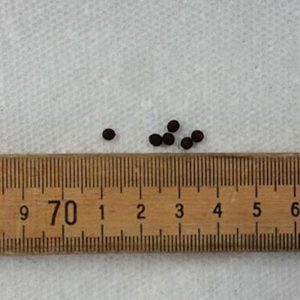
Crazy worms change the soil by accelerating the decomposition of leaf litter on the forest floor. They turn good soil into grainy, dry worm castings (poop) that cannot support the understory plants of our forests. Other plants, animals, and fungi disappear because the understory community can no longer support them. As the understory plants disappear, invasive exotic plants may take their place and further exacerbate the loss of plant species diversity.
In nurseries and greenhouses, crazy worms reduce the functionality of soils and planting media and cause severe drought symptoms. After irrigating or rains, crazy worms may be found under pots. Crazy worms can be inadvertently moved with nursery stock in soil, or in mulch and compost.
More than other earthworms, crazy worms have a voracious appetite, speedy life cycle and a competitive edge. Crazy worms tend to outcompete the other earthworms and soil microbiota where they’re established. They may cause long-term harm to the forests of Maine, which are already under pressure from other invasive insects, plants, pathogens, and diseases. We need to slow the spread of crazy worms in Maine to help reduce the threat to Maine’s natural communities.
Crazy worm Best Management Practices
- Do not buy or use crazy worms for composting, vermicomposting, gardening, or bait.
- Don’t discard live worms in the wild; dispose of them in the trash (preferably dead).
- Check your plantings; know what you are purchasing and look at the soil.
- Buy bare root plants when possible.
- Be careful when sharing or moving plantings; tiny earthworm cocoons (3 mm diameter) may be in the soil (see photo above).
- Map it! Please visit the DACF iMap Invasives web page for more information
- Questions? Call Gary Fish 207.287.7545 or email gary.fish@maine.gov.
For more information, visit the DACF website.
Caulophyllum thalictroides: A Native Plant for Pollinators and Gardeners
By Leala Machesney, Environmental Horticulture Student at the University of Maine
Blue cohosh (Caulophyllum thalictroides) is an herbaceous perennial native to the eastern United States with a long history of medicinal use by Native American tribes. Here in Maine, blue cohosh has been historically documented in Somerset, Penobscot, Aroostook, Kennebec, Waldo, Oxford, and Franklin counties. Indigenous peoples would use the plant’s rhizome to treat a variety of health concerns including stomach pain, rheumatism, and painful menstruation. While blue cohosh is still used in alternative medicine, it has not been proven to be medically effective and research suggests consumption by pregnant women may cause birth defects. Medicinal use aside, the ecological and ornamental value of blue cohosh is considerable.
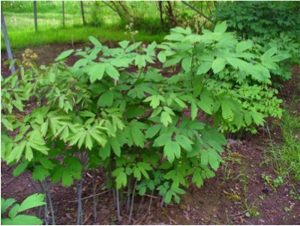
Shoots surface in April with beloved spring ephemerals like jack-in-the-pulpit (Arisaema triphyllum) and red trillium (Trillium erectum). The foliage of these emerging plants is an attractive blue-green, and one of blue cohosh’s major ornamental features. The delicate, divided leaves resemble plants in the genus Thalictrum, commonly called meadow-rues. The specific epithet of blue cohosh, “thalictroides,” is a reference to this similarity.
Blue cohosh flowers early in the spring, but its blooms are unremarkable. The flowers are small and tend to be a mundane chartreuse or brown. While the flowers may not be striking, they do serve as an excellent source of nectar for visiting insects at a time of year when few other plants are in bloom. Frequent visiting insects includes syrphid and tachinid flies. Syrphid flies, or hoverflies, are pollinators of many plants, while tachinid flies are parasites of garden pests like Japanese beetles and tent caterpillars.

Brilliant blue single-seeded fruits mature on plants in midsummer adding a pop of color in the landscape that can persist into fall. While woodland birds may help themselves to some of the attractive fruits and white-tailed deer may occasionally graze on the foliage, blue cohosh isn’t the food of choice for these organisms. All parts of blue cohosh contain alkaloids and glycosides, which are toxic to mammals and taste very bitter. If gardeners do wake to find some of the ornamental seeds have been sampled by fauna, they shouldn’t be frustrated. It can be difficult to encourage seed germination in blue cohosh, but dispersers like birds and deer efficiently spread the plant around forests. Blue cohosh can thrive in an area for many years once seeds have successfully germinated.
Those seeking to add blue cohosh to their gardens should try to replicate the plant’s natural environment. Typically, blue cohosh can be found in full or partial shade in the understory of deciduous forests. Gardeners should provide blue cohosh with consistently moist, loamy soil. However, if blue cohosh is ensured a location with soil high in organic matter and protective shade, soil moisture shouldn’t be a concern. Because blue cohosh is hardy to zones 4 through 7, the plant will overwinter reliably in most parts of Maine. Mulch can be applied to protect against winter cold after the foliage has died back in September. While blue cohosh isn’t a plant you’d typically see at your local nursery, it makes a beautiful addition to the landscape of any ecologically-conscious gardener with an appreciation for native gems.
References
- “Blue Cohosh (Caulophyllum thalictroides).” University of Illinois Extension, extension.illinois.edu/wildflowers/directory_detail.cfm?PlantID=820&page=1.
- “Caulophyllum thalictroides.” Missouri Botanical Garden, www.missouribotanicalgarden.org/PlantFinder/PlantFinderDetails.aspx?kempercode=j700.
- “Blue cohosh (Caulophyllum thalictroides).” Skidmore College, https://academics.skidmore.edu/wikis/NorthWoods/index.php/Caulophyllum_thalictroides_%28Blue_Cohosh%29 [retrieved April 2019].
- Satchithanandam, Subramaniam, et al. “Alkaloids and Saponins in Dietary Supplements of Blue Cohosh (Caulophyllum thalictroides).” Journal of AOAC International, vol. 91, no. 1, 2008, pp. 21.
- Haines, Arthur, et al. New England Wildflower Society’s Flora Novae Angliae: A Manual for the Identification of Native and Naturalized Vascular Plants of New England. New England Wild Flower Society, Framingham, MA, New Haven, CT, 2011.
- Sole, Deb. “Blue Cohosh.” The Maine Organic Farmer & Gardener. Maine Organic Farmers and Gardeners Association, http://www.mofga.org/Publications/The-Maine-Organic-Farmer-Gardener/Winter-2003-2004/Blue-Cohosh. Winter 2003/2004.
Adopt a Family: A Unique Approach to Matching Small-scale Growers with Young Maine Families
By Kate Garland, Horticulturist, UMaine Extension Penobscot County
We’re all familiar with the trees adorned with tags listing a child’s name and their holiday wishes that pop up in shopping centers, businesses, and banking institutions in early December. This concept served as the inspiration behind a new UMaine Extension Maine Harvest for Hunger initiative called Adopt-a-Family. Here’s how it works:
Partnering with Maine Families, a home visiting program serving households with children from birth to age 3, we asked five families to create a small wish list of produce items they’d like to receive. Small-scale growers (mainly Master Gardener Volunteers) were emailed wish lists and asked if they’d be willing to commit to donating enough produce to fill at least two grocery bags that season. Wish lists were completely anonymous, but did give some basic information about the household. For example, family #1 would be listed as 1 adult and 3 children wishing for beans, tomatoes, carrots, and onions. Throughout the growing season, donors would drop off produce at the Extension office. Extension staff would then contact Maine Families staff who would deliver the produce along with Extension recipes and food handling tips.
This approach to engaging volunteers and donor families addressed some important barriers that often get in the way of involvement for both audiences.
Benefits for donors:
- Convenient hours. Unlike many food pantries, our office is open Monday through Friday, 8:00 AM – 4:30 PM.
- Familiar drop-off site. All donors had already taken classes at our office so they knew our location.
- Small donations were welcomed. Home gardeners often feel their extra bag of beans (for example) aren’t going to make enough of an impact at area pantries, but donors in this program could picture what a difference their contributions made in the lives of others.
- Personal contact. Even though the families were anonymous, the volunteers knew that they were helping people who were appreciative of their generosity.
Benefits to families:
- Home delivery. Transportation and the scheduling challenges of making it to a food pantry during specific hours can be a huge barrier for families.
- No paperwork. They didn’t need to enroll or fill any forms to participate.
- Familiar produce. Families received items they knew they’d enjoy.
- Recipes and food safety tips. We often tucked in low-cost recipes and food preservation information, such as freezing tips, when we had a lot of a certain item.
As we go into our third season with the program, we are excited to share our success and hopefully inspire this program to launch elsewhere in Maine and beyond. Please contact katherine.garland@maine.edu (207.942.3423) if you’d like to learn more.
Food & Nutrition: Food Safety and Backyard Flock
By Kathy Savoie, MS,RD, UMaine Extension Cumberland County

Owning backyard chickens and other poultry can be a great experience. However, children and other groups of people have a greater chance of illness from handling live poultry or anything in the area where they live and roam. Even handling baby birds displayed at stores can cause a Salmonella infection.
Live poultry might have Salmonella germs in their droppings and on their bodies (feathers, feet, and beaks), even when they appear healthy and clean. The germs can get on cages, coops, feed and water dishes, hay, plants, and soil in the area where the birds live and roam. Germs also can get on the hands, shoes, and clothes of people who handle or care for the birds.
People become infected with Salmonella germs when they put their hands or equipment that has been in contact with live poultry in or around their mouth. Young children are more likely to get sick because their immune systems are still developing and they are more likely to put their fingers or pacifiers and other items into their mouths.
People who have contact with items, like coops or water dishes, in the area where poultry live can get sick without actually touching one of the birds. Germs on your hands can spread easily to other people or surfaces, which is why it’s important to wash hands immediately with soap and water after touching poultry or anything in the area where they live and roam.
Take these steps to reduce your chances of getting Salmonella:
- Always wash your hands with soap and water right after touching live poultry or anything in the area where they live and roam.
- Adults should supervise hand washing by young children.
- Don’t let live poultry inside the house, especially in areas where food or drink is prepared, served, or stored.
- Set aside a pair of shoes to wear while taking care of poultry and keep those shoes outside of the house.
- Don’t let children younger than 5 years, adults older than 65, or people with weakened immune systems from conditions such as cancer treatment, HIV/AIDS or organ transplants, handle or touch chicks, ducklings, or other live poultry.
- Don’t eat or drink in the area where the birds live or roam.
- Don’t kiss your birds or snuggle them and then touch your face or mouth.
- Stay outdoors when cleaning any equipment or materials used to raise or care for live poultry, such as cages or feed or water containers.
- Buy live poultry from hatcheries that participate in the U.S. Department of Agriculture National Poultry Improvement Plan (USDA-NPIP). This program is intended to reduce the incidence of Salmonella in baby poultry in the hatchery, which helps prevent the spread of illness among poultry and people.
Symptoms of Salmonella Infection
Salmonella germs can make people sick with:
- Diarrhea
- Vomiting
- Fever
- Abdominal cramps
University of Maine Cooperative Extension’s Maine Home Garden News is designed to equip home gardeners with practical, timely information.
Let us know if you would like to be notified when new issues are posted. To receive e-mail notifications fill out our online form.
For more information or questions, contact Kate Garland at katherine.garland@maine.edu or 1.800.287.1485 (in Maine).
Visit our Archives to see past issues.
Maine Home Garden News was created in response to a continued increase in requests for information on gardening and includes timely and seasonal tips, as well as research-based articles on all aspects of gardening. Articles are written by UMaine Extension specialists, educators, and horticulture professionals, as well as Master Gardener Volunteers from around Maine, with Katherine Garland, UMaine Extension Horticulturalist in Penobscot County, serving as editor.
Information in this publication is provided purely for educational purposes. No responsibility is assumed for any problems associated with the use of products or services mentioned. No endorsement of products or companies is intended, nor is criticism of unnamed products or companies implied.
© 2019
Call 800.287.0274 (in Maine), or 207.581.3188, for information on publications and program offerings from University of Maine Cooperative Extension, or visit extension.umaine.edu.

